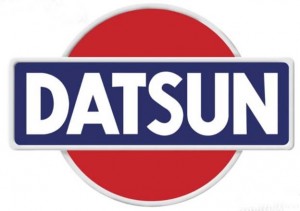A once-familiar is apparently getting ready to make its return – but the revival of the old Datsun brand will be targeted at new and emerging markets.
Expanding upon recent rumors, Japan’s well-regarded Nikkei news service reports the Datsun name once used by Nissan in major markets such as the U.S. will make its return in 2014. But the “new” Datsun won’t replace Nissan is the States, Japan or other established markets. Instead, it will be dusted off to serve as a back-up brand for Nissan’s lowest-priced entries in emerging markets such as India, Indonesia and Russia.
Plans call for Datsun-branded vehicles to be produced in those markets, as well.
The Japanese business publication suggests that Nissan will target vehicles in the price range of around 500,000 yen, or US$6,200.
Nissan Motor Co.’s goals are moderately ambitious, with sales forecast at around 300,000 annually in the near-term.
In a sense, the reborn brand would be returning to its roots. The name was created in 1931 – though then spelled Datson – to differentiate a line of small cars sold by the DAT Motorcar Co. of Japan. The spelling was later changed to Datsun because “son” can be translated to mean “loss” in Japanese. The parent company eventually became part of what is known as Nissan today.
The name was used for Nissan when it came to the United States after the Second World War but created a bit of confusion on a global scale. The automaker decided to switch to its correct badge, beginning to phase out the Datsun name in 1986. But the transition created more confusion than it solved, especially among American consumers, and was blamed for years of weak sales by the newly renamed Nissan in the American marketplace.
Talk of reviving the Datsun brand has been floating around for years, but gained momentum as Nissan CEO Carlos Ghosn began pressing the maker to target emerging markets, such as China, Brazil, India and Russia.
The strategy, insiders suggest, would help protect the more up-market corporate identity from being diluted by stripped-down products sold as Datsuns. The same strategy has been used, in various ways, by other makers.
General Motors introduced the Chevrolet brand to Europe, a few years back, to handle base-model, Korean-made products priced significantly below the offerings of the German-based Opel brand. More recently, GM and its Chinese partner SAIC have launched Baojun, a low-cost brand targeting first-time buyers outside the booming cities along China’s Pacific coast.
Volkswagen, meanwhile, uses entry-level brands like Spanish-based SEAT and Czech Republic’s Skoda to deal with buyers on a budget, rather than moving the mainstream VW marque down-market.
Officials from Nissan were not available to comment on the Nikkei report.


That’s a very good marketing maneuver. The revival of an old familiar name can give a new segment a jump start without diluting the original.
The brand name change from DATSUN to NISSAN started with the 1980 model year here in the US and was completed by 1983. Many people believe that changing the Brand Name was one of the worst cases of Brand Management, and/or Corporate Blunders of the 20th Century. Nissan sales in the US dropped from 2nd place among imports, to as low as 5th place over the following years. Resting on near bankruptcy by 1996.
It would seem that Nissan still doesn’t get it. While Toyota introduced their SCION brand to attract youthful buyers at the low end price range and compete with the raising sales of Korean imports here; Nissan seems set on ignoring the younger generations of buyers.
Seems sad to waist such a rich and successful heritage, which the DATSUN Brand has in the US, on emerging markets that for the most part are completely unaware of it. Wonder how many people in China and India restore 49 year old Datsun Z’s and 510’s?
Hi, Jeff,
I recall writing many a story about the Nissan/Datsun fiasco. It helped push the company into the Renault/Nissan Alliance — well, maybe a good outcome to a bad situation.
I have to suggest that while Scion might seem a good comparison it has not been nearly as successful as Toyota likes to portray it. The brand clearly generated a lot of enthusiasm early on, ie with the original xB, but sales have been way off in recent years. And while the Scion brand generates a low average owner age — among the industry’s lowest — I do not see data supporting the idea that it is actually doing much for the parent Toyota brand by bringing in more, and younger, buyers. Let’s see what happens with the new sports car.
Should Nissan restore the Datsun brand here? Interesting concept but I don’t sense any plans are in the works.
Paul A. Eisenstein
Publisher, TheDetroitBureau.com